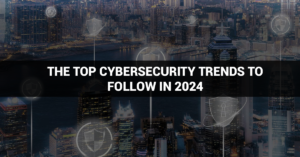
Emphasizing cybersecurity is crucial in addressing cyber threats and preventing unauthorized access. Small businesses, large companies, governments, and organizations worldwide run activities efficiently through computerized systems. With new advancements in technology, the field of cybersecurity changes and transforms; hence, professionals need to continuously enhance their knowledge and skills in securing data amidst ever-changing threats.
Top Trends in Cybersecurity

-
AI in Cybersecurity
AI can play a vital role in enhancing cybersecurity. It is responsible for detecting and responding to threats and managing complex attacks that hackers may undertake. With a powerful AI partner in the battle against cyber threats, the future of cybersecurity appears promising.
-
Mobile Devices as Targets
Increased usage of mobile devices has resulted in frequent attacks on mobile banking and personal data. It is necessary to enhance mobile security measures, requiring vigilance to maintain data security.
-
Challenges of Cloud Security
Organizations increasingly dependent on cloud services should develop strategies to combat user-end malicious attacks and phishing.
-
Persistent Data Breaches
Cybersecurity threats are relentless. Thus, companies must adhere to rules set by regulatory bodies like GDPR.
-
Automation in Cybersecurity
Automation helps cybersecurity professionals deal with big data and ensures software protection. Identifying and embedding security in agile development ensures more secure software solutions, particularly for large and complex applications.
-
State-Sponsored Cyber Warfare
More and more states are launching cyber attacks against networks and data that require specific protection.
-
Cyber Security in Remote Work
Telecommuting poses added risks that secure VPNs and multi-factor authentication should prevent when securing remote workers.
-
Countering Social Engineering Attacks
Social engineering will play an integral role in scenarios that target human limitations. Therefore, the need to train employees and improve safety measures will arise.
-
Multi-Factor Authentication (MFA)
MFA offers a solution to controlling unauthorized access, making cybersecurity one of the most essential segments.
-
Implement Secure Identity and Access Management
Efficient identity and access management minimize the possibility of losing sensitive information and networks to illegal cyber attacks.
-
Real-Time Monitoring
Real-time monitoring will identify cyber threats in time, allowing effective and efficient countermeasures in real-time to prevent damage.
-
AI for Enhanced Security
Artificial intelligence techniques are crucial and necessary for cybersecurity, for they can offer a proactive measure of threat detection.
-
Security of IoT Devices
With the advancement of IoT devices, organizations need to schedule updates and address potential risks.
-
Cloud Security Setting
Encryption, authentication, and patching improve cloud security due to enhanced vulnerability to cyber risks.
Moving To The Next Level with Cyber Security Trends

-
AI and ML in Cybersecurity
Artificial intelligence and machine learning will be crucial in future cybersecurity techniques. Improving cybersecurity by prioritizing threat identification using AI, abnormality detection, and automated response systems is essential.
-
Zero Trust Security Models
Traditional perimeter-based security models will become more restrictive, and there will be a shift towards Zero-Trust Architecture. The principles of the ZTA entail never trusting and consistently verifying, which, when done continuously in this architecture, would increase the protection accorded to sensitive data and resources.
-
Quantum Computing Resistant Cryptography
With the development of technology in quantum computation, the need for developing quantum computing-resistant cryptography will arise. Companies and businesses will soon have to upgrade to new cryptographic techniques that can reject quantum hacks.
-
Future of Cloud Security
Companies are keen to secure new cloud-native environments and strive to deal with misconfiguration and data exposure threats. Security technologies, such as CASBs and CSPM, will gain prominence.
-
5G Network Security
Implementing 5G networks requires a strong focus on security. As speed increases and remission reduces, 5G networks face new security risks, such as hacked IoT devices and potential threats to critical infrastructure.
-
IoT Security
Remember the following text:
Securing IoT devices will become increasingly critical as the ecosystem's importance increases. Better security standards, regulations, and proper device management will be essential in companies to counter the cyber threat of insecure IoT devices.
-
Biometric and Behavioral Authentication
Liveness detection and behavioral analysis in facial and fingerprint authentication will increase security and prevent spoofing. Therefore, there will be a growing demand for multi-factor biometric authentication.
-
Privacy Regulation & Data Protection
Privacy regulations will continue to become more stringent over time, with a growing focus on customer data privacy and consent, resulting in businesses adapting to changing international privacy laws.
-
Cybersecurity Workforce Development
This trend of closing the cyber security gap will continue. Comprehensive training programs, certifications, and university-business sector partnerships will be introduced to increase the number of skilled cybersecurity professionals.
-
Automated Threat Hunting
Advanced and predictive threat detection and intelligence platforms will significantly identify and contain potential threats. These solutions will enable businesses to continuously detect threat activity and prevent them from functioning.
-
Regulatory and Legal Challenges
The legal and regulatory landscape changes as new cybersecurity laws and regulations emerge. These operations are complex and coordinated across over 30 countries, and non-compliance could lead to penalties and other legal consequences that may impact restoration.
-
AI-Driven Security Testing
Improvements in penetration testing and using vulnerability assessment information as an application or system testing tool will still make them more powerful tools for revealing the strengths and weaknesses of security systems in use.
-
Response and Recovery Plan
It is essential to develop an incident response and recovery plan testing mechanism. It will create the capability to identify the situation, react to it, and restore things to normal after cyber incidents. Doing so will be crucial in avoiding the consequences of cyber threats.
-
AI-Powered Cybercriminals
Hackers will continue using AI and ML in their attacks, making it difficult for organizations to protect themselves. Adversarial AI will help bypass different forms of protection, considerably improving the potential threat's effectiveness.
-
Ethical Hacking and Bug Bounty Programs
Business entities will continue to develop and practice ethical hacking and bug bounty to expose potential loopholes in their systems. Crowdsourced security testing will be more in demand due to the possibility of discovering and removing security vulnerabilities beforehand.
Cybersecurity is progressively getting more complex daily; therefore, one has to consider as many trends and technologies as possible to keep up with threats. Areas of particular note include advanced AI with machine learning, enhanced biometric authentication, and robust cloud and IoT security. Stronger privacy regulations, increased calls for influential professionals, and mandated constant development and training are crucial. Responding proactively to these trends will better protect organizations from the changing environment of cyber threats.

